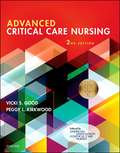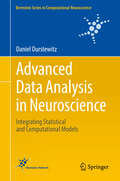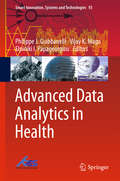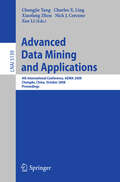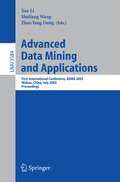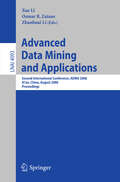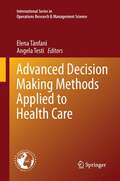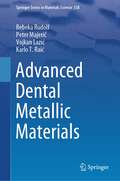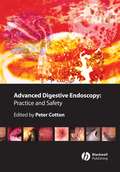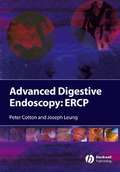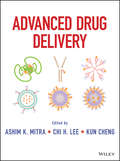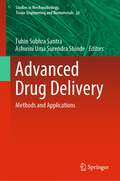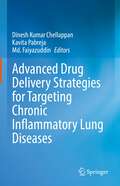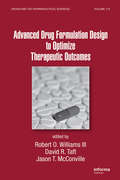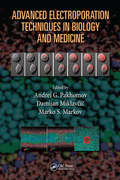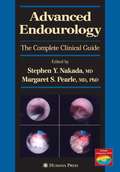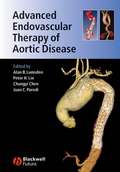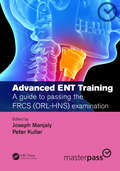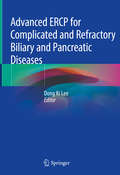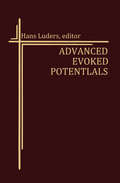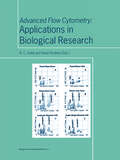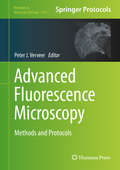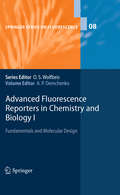- Table View
- List View
Advanced Critical Care Nursing - E-Book
by Vicki S. Good Peggy L. KirkwoodAwarded third place in the 2017 AJN Book of the Year Awards in the Critical Care- Emergency Nursing category. Learn to effectively address life-threatening and potentially life-threatening patient conditions, with Advanced Critical Care Nursing, 2nd Edition. Endorsed by the American Association of Critical-Care Nurses (AACN), this comprehensive, nursing-focused text centers on the clinical reasoning process as it helps you comprehend, analyse, synthesize, and apply advanced critical care knowledge and concepts. The book is organized within the structure of body systems along with synthesis chapters that address patient conditions involving multiple body systems. Numerous illustrations and graphs plus unfolding case studies further aid your understanding and help you apply text content. In all, Advanced Critical Care Nursing is the must-have resource dedicated to helping you oversee or care for critical care patients in any practice setting. Body systems organization emphasizes core systems and advanced concepts. Consistent chapter format features numerous illustrations, charts, and graphs in each chapter to enhance understanding.Synthesis chapters address patient conditions that involve multiple body systems — a common occurrence in critical care nursing.Unfolding case studies with decision point questions are included at the end of all disorders chapters, providing opportunities to apply advanced critical care content to actual scenarios.Medication tables incorporate common classifications of critical care drugs for specific disorders, including drugs, actions, and special considerations.NEW! Updated information throughout reflects the latest evidence-based content as well as national and international treatment guidelines.NEW! Streamlined content places a greater focus on the need-to-know information for today’s high acuity, progressive, and critical care settings.NEW! Expanded coverage of emerging and infectious diseases and multidrug-resistant infections keep readers up to date with the most topical diseases, such as the Zika virus.NEW! Additional content on alternative settings for critical care now includes the eICU and remote monitoring. NEW! Full-color design clarifies important concepts and improve the book's usability.
Advanced Data Analysis in Neuroscience: Integrating Statistical and Computational Models (Bernstein Series in Computational Neuroscience)
by Daniel DurstewitzThis book is intended for use in advanced graduate courses in statistics / machine learning, as well as for all experimental neuroscientists seeking to understand statistical methods at a deeper level, and theoretical neuroscientists with a limited background in statistics. It reviews almost all areas of applied statistics, from basic statistical estimation and test theory, linear and nonlinear approaches for regression and classification, to model selection and methods for dimensionality reduction, density estimation and unsupervised clustering. Its focus, however, is linear and nonlinear time series analysis from a dynamical systems perspective, based on which it aims to convey an understanding also of the dynamical mechanisms that could have generated observed time series. Further, it integrates computational modeling of behavioral and neural dynamics with statistical estimation and hypothesis testing. This way computational models in neuroscience are not only explanatory frameworks, but become powerful, quantitative data-analytical tools in themselves that enable researchers to look beyond the data surface and unravel underlying mechanisms. Interactive examples of most methods are provided through a package of MatLab routines, encouraging a playful approach to the subject, and providing readers with a better feel for the practical aspects of the methods covered. "Computational neuroscience is essential for integrating and providing a basis for understanding the myriads of remarkable laboratory data on nervous system functions. Daniel Durstewitz has excellently covered the breadth of computational neuroscience from statistical interpretations of data to biophysically based modeling of the neurobiological sources of those data. His presentation is clear, pedagogically sound, and readily useable by experts and beginners alike. It is a pleasure to recommend this very well crafted discussion to experimental neuroscientists as well as mathematically well versed Physicists. The book acts as a window to the issues, to the questions, and to the tools for finding the answers to interesting inquiries about brains and how they function." Henry D. I. Abarbanel Physics and Scripps Institution of Oceanography, University of California, San Diego “This book delivers a clear and thorough introduction to sophisticated analysis approaches useful in computational neuroscience. The models described and the examples provided will help readers develop critical intuitions into what the methods reveal about data. The overall approach of the book reflects the extensive experience Prof. Durstewitz has developed as a leading practitioner of computational neuroscience. “ Bruno B. Averbeck
Advanced Data Analytics in Health (Smart Innovation, Systems and Technologies #93)
by Philippe J. Giabbanelli Vijay K. Mago Elpiniki I. PapageorgiouThis book introduces readers to the methods, types of data, and scale of analysis used in the context of health. The challenges of working with big data are explored throughout the book, while the benefits are also emphasized through the discoveries made possible by linking large datasets. Methods include thorough case studies from statistics, as well as the newest facets of data analytics: data visualization, modeling and simulation, and machine learning. The diversity of datasets is illustrated through chapters on networked data, image processing, and text, in addition to typical structured numerical datasets. While the methods, types of data, and scale have been individually covered elsewhere, by bringing them all together under one “umbrella” the book highlights synergies, while also helping scholars fluidly switch between tools as needed. New challenges and emerging frontiers are also discussed, helping scholars grasp how methods will need to change in response to the latest challenges in health.
Advanced Data Mining and Applications: 4th International Conference, ADMA 2008, Chengdu, China, October 8-10, 2008, Proceedings (Lecture Notes in Computer Science #5139)
by Nick Cercone Xue Li Changjie Tang Charles X. Ling Xiaofang ZhouThe Fourth International Conference on Advanced Data Mining and Applications (ADMA 2008) will be held in Chengdu, China, followed by the last three successful ADMA conferences (2005 in Wu Han, 2006 in Xi'an, and 2007 Harbin). Our major goal of ADMA is to bring together the experts on data mining in the world, and to provide a leading international forum for the dissemination of original research results in data mining, including applications, algorithms, software and systems, and different disciplines with potential applications of data mining. This goal has been partially achieved in a very short time despite the young age of the conference, thanks to the rigorous review process insisted upon, the outstanding list of internationally renowned keynote speakers and the excellent program each year. ADMA is ranked higher than, or very similar to, other data mining conferences (such as PAKDD, PKDD, and SDM) in early 2008 by an independent source: cs-conference-ranking. org. This year we had the pleasure and honor to host illustrious keynote speakers. Our distinguished keynote speakers are Prof. Qiang Yang and Prof. Jiming Liu. Prof. Yang is a tenured Professor and postgraduate studies coordinator at Computer Science and Engineering Department of Hong Kong University of Science and Technology. He is also a member of AAAI, ACM, a senior member of the IEEE, and he is also an as- ciate editor for the IEEE TKDE and IEEE Intelligent Systems, KAIS and WI Journals.
Advanced Data Mining and Applications: First International Conference, ADMA 2005, Wuhan, China, July 22-24, 2005, Proceedings (Lecture Notes in Computer Science #3584)
by Xue Li Shuliang Wang Zhao Yang DongAdvanced Data Mining and Applications: Second International Conference, ADMA 2006, Xi'an, China, August 14-16, 2006, Proceedings (Lecture Notes in Computer Science #4093)
by Xue Li Osmar R. Zaiane Zhanhuai LiHere are the proceedings of the 2nd International Conference on Advanced Data Mining and Applications, ADMA 2006, held in Xi'an, China, August 2006. The book presents 41 revised full papers and 74 revised short papers together with 4 invited papers. The papers are organized in topical sections on association rules, classification, clustering, novel algorithms, multimedia mining, sequential data mining and time series mining, web mining, biomedical mining, advanced applications, and more.
Advanced Decision Making Methods Applied to Health Care (International Series in Operations Research & Management Science #173)
by Elena Tànfani and Angela TestiThe most difficult part of making decisions in the health care field on all levels (national, regional, institutional, patient) is linked to the very complexity of the system itself, to the intrinsic uncertainty involved and its dynamic nature. This requires not only the ability to analyze and interpret a large amount of information but also arrange it so that it becomes a cognitive base for appropriate decision-making. Moreover, decisions in the health care field are subjected to many challenges and constraints: fast change and uncertain outcomes, aging population, increasing citizen expectations, equity considerations and limited resources. Operations research, statistical and economic-related quantitative methods supply these decisions making tools and methodology. The contributed book presents a collection of applications to concrete situations detailing the problem area, the methodology employed, the implementation and results. Each topic addressed in the book will be structured in such a way that an interdisciplinary and wide audience will be able to use the materials presented. As an example the book chapters will address health policies issues, planning health services, epidemiology and disease modelling, home-care modelling, logistics in health care, capacity planning, quality and appropriateness.
Advanced Dental Metallic Materials (Springer Series in Materials Science #338)
by Rebeka Rudolf Peter Majerič Vojkan Lazić Karlo T. RaićThis book delivers a broad and concise look at advanced metallic materials used for dental applications. Due to their excellent mechanical and biological properties, the use of metallic materials in dentistry has continued since time immemorial. In that sense, this book aims to bring the readers closer to the specific purpose of dental metallic materials meeting specific criteria and materials properties such as biocompatibility, non-toxicity, resistance to corrosion, long-term durability, appropriate strength and toughness, as well as corresponding values of modulus of elasticity. Following a comprehensive introduction to the field, the book discusses topical issues such as the long-term stability of dental titanium implants, processing of cobalt-chrome dental alloys, emerging gold dental alloys, and novel nanofoils used for dental joining. Featuring numerous illustrative examples of experimental outcomes, this book is an ideal resource for materials scientists and metallurgists working on advanced alloys for dental applications.
Advanced Digestive Endoscopy: Practice and Safety
by Peter B. CottonEssential new title in the Advanced Digestive Endoscopy series Advanced Digestive Endoscopy: Practice & Safety provides a practical manual on how to perform techniques safely and effectively in order to maximise value, and to reduce risks. Clearly structured, it covers training, endoscopy and imaging equipment, infection control, patient preparation and monitoring, complications and how to avoid and deal with them. Expanding on the content of Peter Cotton’s best-selling Practical Gastrointestinal Endoscopy, this instructive volume contains information and guidelines on all aspects of the practice of endoscopy, and is an ideal companion for both the trainee and the experienced endoscopist. Key features include: Written by the leading international names in endoscopy Text has been expertly edited by Peter Cotton into a succinct and instructive format Presented in short paragraphs structured with headings, subheadings and bullet points Richly illustrated throughout with full-color photographs
Advanced Digestive Endoscopy: ERCP
by Peter B. Cotton Joseph W. LeungAdvanced Digestive Endoscopy: ERCP addresses some of the most complex diagnostic and therapeutic procedures for endoscopists. It provides the latest thinking and clear instruction on the techniques, which have been integrated with overall patient care. Written by the leading international names in endoscopy, the text has been expertly edited by Peter Cotton into a succinct, instructive format. Presented in short paragraphs structured with headings, subheadings and bullet points and richly illustrated throughout with full-color photographs.
Advanced Drug Delivery
by Ashim Mitra Chi H. Lee Kun ChengProvides both fundamentals and new and emerging applications Advanced Drug Delivery brings readers fully up to date with the state of the science, presenting the basics, formulation strategies, and therapeutic applications of advanced drug delivery. The book demonstrates how core concepts of pharmaceutical sciences, chemistry, and molecular biology can be combined and applied in order to spark novel ideas to design and develop advanced drug delivery systems for the treatment of a broad range of human diseases. Advanced Drug Delivery features contributions from an international team of pharmaceutical scientists. Chapters reflect a thorough review and analysis of the literature as well as the authors' firsthand experience developing drug delivery systems. The book is divided into four parts: Part I, Introduction and Basics of Advanced Drug Delivery, explores physiological barriers, stability, transporters, and biomaterials in drug delivery Part II, Strategies for Advanced Drug Delivery, offers tested and proven strategies for advanced delivery of both small molecules and macromolecules Part III, Translational Research of Advanced Drug Delivery, focuses on regulatory considerations and translational applications of advanced drug delivery systems for the treatment of cardiovascular diseases, cancer, sexually transmitted diseases, ophthalmic diseases, and brain diseases Part IV, Future Applications of Advanced Drug Delivery in Emerging Research Areas, examines stem cell research, cell-based therapeutics, tissue engineering, and molecular imaging Each chapter provides objectives and assessment questions to help readers grasp key concepts and assess their knowledge as they progress through the book. Advanced Drug Delivery is recommended for graduates and upper-level undergraduates in the pharmaceutical sciences who need a solid foundation in the basics. It is also recommended for pharmaceutical professionals who want to take advantage of new and emerging applications in advanced drug delivery systems.
Advanced Drug Delivery
by Ashim Mitra Chi H. Lee Kun ChengProvides both fundamentals and new and emerging applications Advanced Drug Delivery brings readers fully up to date with the state of the science, presenting the basics, formulation strategies, and therapeutic applications of advanced drug delivery. The book demonstrates how core concepts of pharmaceutical sciences, chemistry, and molecular biology can be combined and applied in order to spark novel ideas to design and develop advanced drug delivery systems for the treatment of a broad range of human diseases. Advanced Drug Delivery features contributions from an international team of pharmaceutical scientists. Chapters reflect a thorough review and analysis of the literature as well as the authors' firsthand experience developing drug delivery systems. The book is divided into four parts: Part I, Introduction and Basics of Advanced Drug Delivery, explores physiological barriers, stability, transporters, and biomaterials in drug delivery Part II, Strategies for Advanced Drug Delivery, offers tested and proven strategies for advanced delivery of both small molecules and macromolecules Part III, Translational Research of Advanced Drug Delivery, focuses on regulatory considerations and translational applications of advanced drug delivery systems for the treatment of cardiovascular diseases, cancer, sexually transmitted diseases, ophthalmic diseases, and brain diseases Part IV, Future Applications of Advanced Drug Delivery in Emerging Research Areas, examines stem cell research, cell-based therapeutics, tissue engineering, and molecular imaging Each chapter provides objectives and assessment questions to help readers grasp key concepts and assess their knowledge as they progress through the book. Advanced Drug Delivery is recommended for graduates and upper-level undergraduates in the pharmaceutical sciences who need a solid foundation in the basics. It is also recommended for pharmaceutical professionals who want to take advantage of new and emerging applications in advanced drug delivery systems.
Advanced Drug Delivery: Methods and Applications (Studies in Mechanobiology, Tissue Engineering and Biomaterials #26)
by Tuhin Subhra Santra Ashwini Uma Surendra ShindeThis book provides an overview of various drug delivery systems at the cellular level including biological, chemical methods, and most importantly physical methods such as photoporation, electroporation, mechanoporation, and device-based techniques (e.g., microfluidics), as well as organism-level techniques including nanomaterials, biomaterials, and transdermal. Drug delivery (DD) can be defined as the method and route by which an active pharmaceutical ingredient (API) is administered to promote its desired pharmacological effect and/or convenience and/or to reduce adverse effects. Drug delivery systems are developed to maximize drug efficacy and minimize side effects. As drug delivery technologies improve, the drug becomes safer and more comfortable for patients to use. During the last seven decades, extraordinary progress has been made in drug delivery technologies, such as systems for long-term delivery for months and years, localized delivery, and targeted delivery. The advances, however, will face the next phase considering the future technologies that we need to overcome many physicochemical barriers for new formulation development and biological unknowns for treating various diseases. Thus, various technologies are built at a single-cell level as well as an organism level. This book is useful at the university level for graduate courses or research studies and biotechnology-based companies with research and development on cell-based analysis, diagnosis, or drug screening. This book is also very useful for researchers in drug delivery technologies, which came in frontier research for the past decade.
Advanced Drug Delivery Strategies for Targeting Chronic Inflammatory Lung Diseases
by Dinesh Kumar Chellappan Kavita Pabreja Md. FaiyazuddinThis book describes the growing clinical and healthcare relevance of nano-therapeutics in treating respiratory diseases. It begins with a brief introduction on the different types of nanoparticles in respiratory disease conditions. It further discusses the current trends in understanding the disease pathology using different in vitro and in vivo models, which are important towards the onsite clinical applications and development of new therapeutics. The book includes exciting topics such as formulation of these nanoparticles, targeting various organelles etc. It also describes the future prospects and challenges in the field. Different chapters are written by researchers actively working in the area of pulmonary diseases. This book is designed to address the requirements of both beginners and specialized scientists involved in pulmonary research. The contents include basic concepts followed by advanced state-of-art monitoring and treatment of diseases. The book is meant for researchers and industry experts in nanotechnology, pharmaceutical sciences and drug design.
Advanced Drug Formulation Design to Optimize Therapeutic Outcomes
by Robert O. Williams David R. Taft Jason T. McConvilleThis title demonstrates how advanced formulation designs and delivery technologies can be used to improve drug efficacy and treatment outcomes in particular therapeutic categories or disease states. It discusses nanoparticle systems for cancer treatments, and also presents cutting edge immono-regulation agents for transplantation and the local targ
Advanced Electroporation Techniques in Biology and Medicine
by Andrei G. Pakhomov Damijan Miklavcic Marko S. MarkovA reflection of the intense study of the effects of electromagnetic fields on living tissues that has taken place during the last decades, Advanced Electroporation Techniques in Biology and Medicine summarizes most recent experimental findings and theories related to permeabilization of biomembranes by pulsed electric fields. Edited by experts and
Advanced Endourology: The Complete Clinical Guide (Current Clinical Urology)
by Stephen Y. Nakada Margaret S. PearleLeading national and international urologists in the field of endourology describe standard and advanced endoscopic procedures for treating upper-tract pathology. The authors provide step-by-step instructions for the latest endoscopic procedures, ranging from upper urinary tract calculi and strictures to urothelial cancer. Advanced Endourology: The Complete Clinical Guide offers practicing urologists and urology residents not only a comprehensive, illustrated guide to endourological techniques-particularly the more advanced procedures-but also a practical means to expand the range and scope of the procedures they perform.
Advanced Endovascular Therapy of Aortic Disease
by Alan B. Lumsden Peter H. Lin Changyi Chen Juan ParodiAt last, years of clinical experience and the latest clinical evidence comes together in one comprehensive collection by world-renown experts at the Baylor College of Medicine. A complete and focused examination of all aspects of endovascular therapy of aortic disease, Advanced Endovascular Therapy provides you with all of the information you need on: Natural history and preoperative planning Thoracic aortic aneurysm Aortic dissection and traumatic aortic injury Techniques, new devices, and surveillance With 26 chapters skilfully organized into four main sections, this book helps you obtain the best results when using endovascular treatments for patients with aortic disease. Keep Advanced Endovascular Therapy close at hand for frequent reference.
Advanced ENT training: A guide to passing the FRCS (ORL-HNS) examination
by Joseph Manjaly Peter KullarThe syllabus for the FRCS (ORL-HNS) is vast and sound preparation for the exams has traditionally involved assimilatiing knowledge from a wide range of sources. This book provides a focussed guide for exam candidates. More than a question and answer book, this book is a coaching manual. Each section features a combination of model answers, pearls of wisdom, checklists and pointers for further reading. Detailed advice is provided for both Part 1 and Part 2 of the examnation. Viva topics that have featured in the exam in recent years have been included. and have then been supplemented by invaluable editorial contributions from leaders in each of the subspecialties. Trainees frequently comment that exam preparation is an enlightening process and the knowledge gained would have served them well during their time as an ENT registrar or Otorhinolaryngology resident.This book will also serve as a valuable learning tool for trainees as early as ST3 and facilitate their development of effective and safe clinical practice.
Advanced ENT training: A guide to passing the FRCS (ORL-HNS) examination
by Joseph Manjaly Peter J KullarThe syllabus for the FRCS (ORL-HNS) is vast and sound preparation for the exams has traditionally involved assimilatiing knowledge from a wide range of sources. This book provides a focussed guide for exam candidates. More than a question and answer book, this book is a coaching manual. Each section features a combination of model answers, pearls of wisdom, checklists and pointers for further reading. Detailed advice is provided for both Part 1 and Part 2 of the examnation. Viva topics that have featured in the exam in recent years have been included. and have then been supplemented by invaluable editorial contributions from leaders in each of the subspecialties. Trainees frequently comment that exam preparation is an enlightening process and the knowledge gained would have served them well during their time as an ENT registrar or Otorhinolaryngology resident.This book will also serve as a valuable learning tool for trainees as early as ST3 and facilitate their development of effective and safe clinical practice.
Advanced ERCP for Complicated and Refractory Biliary and Pancreatic Diseases
by Dong Ki LeeThis book provides a comprehensive overview of non-surgical treatments for complicated and refractory biliary and pancreatic lesions. In particular, it offers non-surgical treatment options for benign biliary strictures. For those suffering from intractable total biliary obstruction following biliary operation, magnetic compression anastomosis represents a good therapeutic option, and this technique is fully explained. Moreover, the book describes diverse treatment modalities for hilar stricture, which is one of the most challenging areas of ERCP. Several chapters cover a variety of important aspects of this area. The book also aims to identify and solve the unmet needs for the diagnosis and treatment of biliary and pancreatic diseases. The precise explanations of treatment concepts and strategies will both increase readers’ knowledge and provide assistance in daily clinical practice. The authors are pioneering experts from around the world, and the text is supported by numerous informative illustrations and helpful summaries.
Advanced Evoked Potentials (Topics in Neurosurgery #2)
by Hans LüdersOver the last twenty to thirty years the progressivcly increasing availability of averaging machines has made evoked potential testing available not only in the major neurological diagnostic centers but also in the office of many neuro logists in private practice. This rapid devclopment was closely paralleled by clinical research in evoked potentials and the publishing of books covering in detail the basic techniques necessary to obtain evoked potentials and the main clinical applications of evoked potentials. Less work was done, however, to define some of the general principles underlying the recording of evoked potentials or to analyze critically the recording techniques or the actual prac tical value of the information provided by evoked potential testing. In this book an attempt has been made to cover this gap. It is assumed that the reader has a good understanding of basic recording techniques and is familiar with the main applications of clinical evoked potentials. The main emphasis of the first two chapters is to define with more precision some of the physical principles that inftuence the volta ge distribution and are used for defining the generator sources of evoked potentials. This is followed by a critical analysis of recording techniques and of its main clinical applications. Finally there is one chapter that gives an overview on application of evoked potentials for surgical monitoring. This is a rapidly growing field that also has been covered only incomplctcly in previous publications.
Advanced Flow Cytometry: Applications in Biological Research
by R. C. Sobti and Awtar KrishanFlow cytometry has rapidly evolved into a technique for rapid analysis of DNA content, cellular marker expression and electronic sorting of cells of interest for further investigations. Flow cytometers are being extensively used for monitoring of cellular DNA content, phenotype expression, drug transport, calcium flux, proliferation and apoptosis. Phenotypic analysis of marker expression in leukemic cells has become an important tool for diagnostic and therapeutic monitoring of patients. Recent studies have explored the use of flow cytometry for monitoring hormone receptor expression in human solid tumors and for studies in human genomics. Contributions in the current volume are based on presentations made at the First Indo-US workshop on Flow Cytometry in which experts from USA, UK and India discussed applications of flow cytometry in biological and medical research. This book will be of interest to post graduates and researchers in the fields of pathology, cytology, cell biology and molecular biology.
Advanced Fluorescence Microscopy: Methods and Protocols (Methods in Molecular Biology #1251)
by Peter J. VerveerThis volume provides an overview of advanced fluorescence microscopy, covering a broad range of methods. Each chapter focuses on a different method and provides a practical guide for application in biological systems. Written in the highly successful Methods in Molecular Biology series format, chapters include introductions to their respective topics, lists of the necessary materials and reagents, step-by-step, readily reproducible laboratory protocols, and tips on troubleshooting and avoiding known pitfalls.Authoritative and cutting-edge, Advanced Fluorescence Microscopy: Methods and Protocols seeks to provide scientists with methods for biological systems that are of interest.
Advanced Fluorescence Reporters in Chemistry and Biology I: Fundamentals and Molecular Design (Springer Series on Fluorescence #8)
by Alexander P. DemchenkoFluorescence reporter is the key element of any sensing or imaging technology. Its optimal choice and implementation is very important for increasing the sensitivity, precision, multiplexing power, and also the spectral, temporal, and spatial reso- tion in different methods of research and practical analysis. Therefore, design of ?uorescence reporters with advanced properties is one of the most important problems. In this volume, top experts in this ?eld provide advanced knowledge on the design and properties of ?uorescent dyes. Organic dyes were the ?rst ?uorescent materials used for analytical purposes, and we observe that they retain their leading positions against strong competition of new materials – conjugated polymers, semiconductor nanocrystals, and metal chelating complexes. Recently, molecular and cellular biology got a valuable tool of organic ?uorophores synt- sized by cell machinery and incorporated into green ?uorescent protein and its analogs. Demands of various ?uorescence techniques operating in spectral, anisotropy, and time domains require focused design of ?uorescence reporters well adapted to these techniques. Near-IR spectral range becomes more and more attractive for various applications, and new dyes emitting in this range are strongly requested. Two-photonic ?uorescence has become one of the major tools in bioimaging, and ?uorescence reporters well adapted to this technique are in urgent need. These problems cannot be solved without the knowledge of fundamental principles of dye design and of physical phenomena behind their ?uorescence response.
